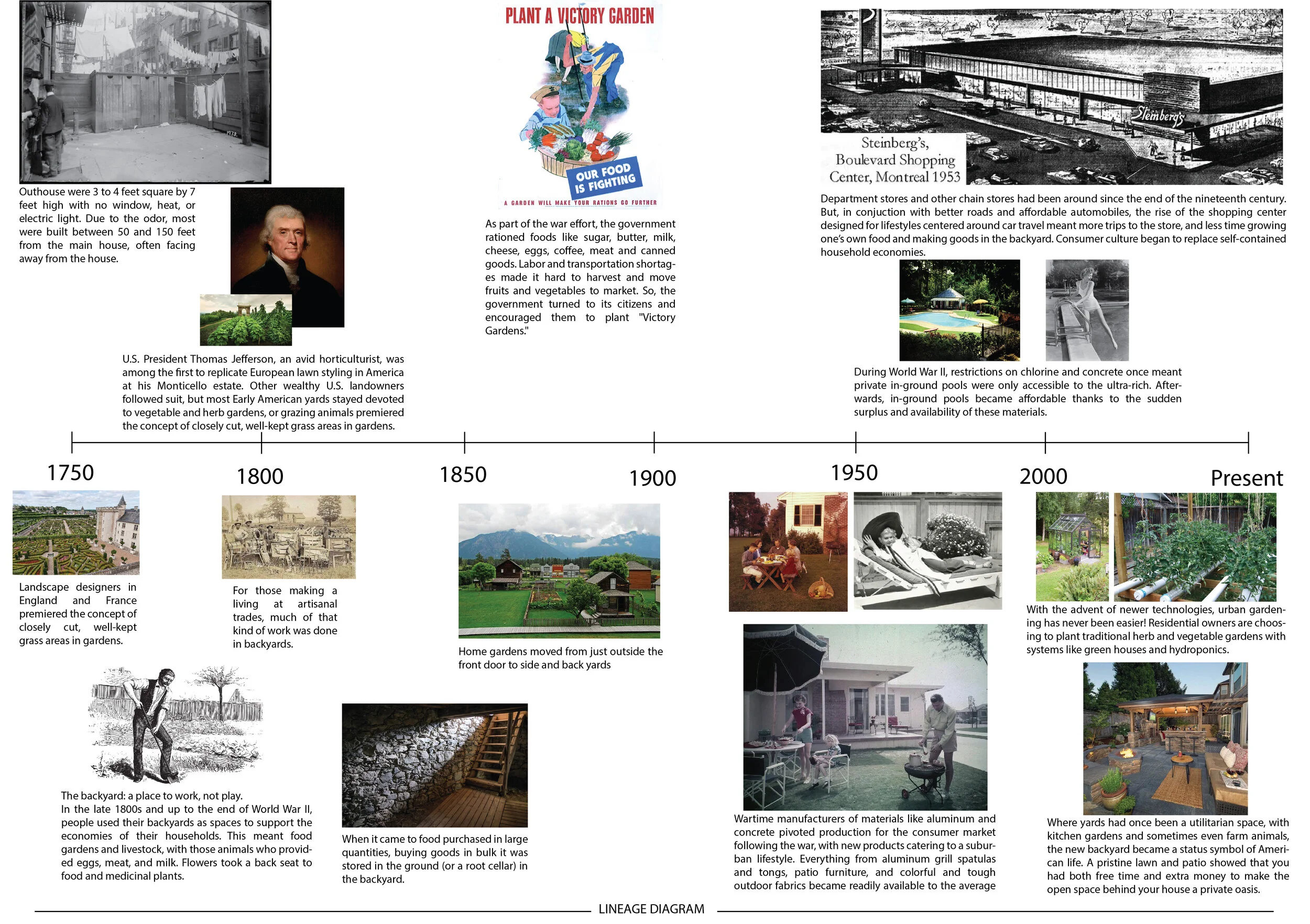Component Development
A Residence in Philadelphia
Community E[m]ergy Diagram for a home
Lineage Diagram of a Backyard
Lineage - Evolution of the backyard as a plot of land:
We started by looking at the backyard from the 1800’s up to the end of WWII, as a place of “work” where the business of the house was carried out, be it food gardens, raising small animals or spaces for artisanal businesses to function. This provided for a level of self-sufficient for the household. With the oncoming of corner convenience stores and a shift to urban office spaces, in the mid-90’s, the backyard turned to a more luxurious status symbol with people building decks, fountains, pools, and barbecue pits. Thus, in a sense, the level of productivity in a backyard decreased. Considering the circularity of history, we observed in the 2000’s there was a switch again as backyards returned to being a place of “work” as the concept of work from home started to evolve, in a entirely sedentary point of view as well as people were more aware of their food source and reliance on the food industry which lead to the whole organic movement leading to a rise in backyard kitchen gardens, hydroponics, small scale greenhouses where people grow their own fruits, vegetables and herbs. The idea of progress is circular as man borrows from the past to help shape the present, and ultimately the future. This is reflected in our spaces, including the backyard.
Hierarchy of Backyards
The hierarchy diagram attempts to evaluate the socio-economic value of different types of components that can be utilized in the backyard. It does so in a two-dimensional graph with four determinants on each axis. The value of the components is subject to change depending on the value the user assigns them.
Taxonomy of Backyards
Observing the taxonomy diagram, we considered combinations of the different “products” which can be introduced into the backyard. In the taxonomy diagram, we have considered the owner's/user's satisfaction as a determinant. This has equal importance as the e[m]ergy yield ratio. Another factor considered is the environmental cost. For instance, an overgrown lawn requires higher resources such as land, water, and sunlight and produces no usable output. As a result, it has high environmental costs. It can be noted that a closed-loop system including a chicken coop, a raised bed vegetable garden, composting bins, and rainwater barrels have the highest e[m]ergy yield to the e[m]ergy input ratio.
Component : Backyard
The “Component” we evaluated is the backyard as a space of production, in contrast, to non-productive space as it currently exists. At the moment, the backyard is a concrete slab with zero output; however, it has a higher e[m]ergy yield potential. The backyard is a vital component of every single-family household, and, when used efficiently, can benefit the homeowner.
The eggs and the vegetables are grown in the garden provide food for the home-owners, which reduces the overall food purchase capacity and frequency between grocery store visits. This ultimately saves fuel.
A part of the original amount of money invested in the backyard is offset over time by the income from the sale of natural compost. As well as the occupant's production of their own eggs, and vegetables.
The concrete pavers used in the backyard are permeable allowing water to seep through to the earth, thus reducing the rainwater run-off that carries pollutants.
Our “Product” in a broader sense is the backyard. We have attempted to design the backyard as a self-sustaining system. The components are in a mutually symbiotic relationship where:
The water collected in the rainwater barrels from the roof rainwater run-off is used to water the raised vegetable beds and as drinking water for the chickens
Kitchen scraps and vegetable waste is used as chicken feed. Further leftovers, along with the chicken waste, are converted into compost, which is highly nutrient-rich. The compost, in turn, is added to the vegetable garden and facilitates the growth of the produce.








![The “Component” we evaluated is the backyard as a space of production, in contrast, to non-productive space as it currently exists. At the moment, the backyard is a concrete slab with zero output; however, it has a higher e[m]ergy yield potent…](https://images.squarespace-cdn.com/content/v1/5ec6aeae30b83c61d2b67ed5/1590669672174-LBBYZ4FT6LQY8JH90TY9/Component+Analysis_Page_31_2.jpg)


